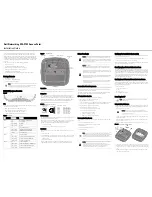
Installing and Connecting an Access Point
2
Copyright © 2012, Juniper Networks, Inc.
The WLA622 is tested for normal operation in temperatures from -30° to 55 °C (-22°
to
131°F).
The WLA632 is tested for an ambient operating temperature range of -40°C to +55°C
(-40 to 131°F).
Wind Velocity
You must consider the known maximum wind velocity and direction at the site and be
sure that any supporting structure, such as a pole, mast, or tower, is built to withstand
this force.
The WLA620, WLA622, and WLA632 can operate in winds up to 144 km/h (90 mph)
and survive higher wind speeds up to 201 km/h (125 mph).
Lightning
The WLA620, WLA622, and WLA632 both include built-in lightning protection.
However, you should make sure that the unit, any supporting structure, and cables are
all properly grounded. Additional protection using lightning rods, lightning arrestors, or
surge suppressors may also be employed.
Rain
The WLA620 and WLA622 units are weatherproofed against rain. Also, prolonged
heavy rain has no significant effect on the radio signal. However, it is recommended
to apply weatherproof sealing tape around the Ethernet port and antenna connectors
for extra protection. If moisture enters a connector, it may cause a degradation in
performance.
The WLA632 weatherproof enclosure is designed to protect against dust, rain, and
water jets.
Snow and Ice
Falling snow, like rain, has no significant effect on the radio signal. However, a build
up of snow or ice on antennas may cause a degradation in performance. In this case,
the snow or ice has to be cleared from the antennas to restore proper operation of
the unit.
Ethernet Cabling
When you have determined a suitable location for the WLA620, WLA622, or WLA632,
you must plan a cable route from the WLA outdoors to the power injector module
indoors. Consider these points:
The Ethernet cable length should never be longer than 100 m (328 ft) over CAT5,
CAT5e, or CAT6 cable.
Determine a building entry point for the cable.
Determine if conduits, bracing, or other structures are required for safety or
protection of the cable.
For lightning protection at the power injector end of the cable, consider using a
lightning arrestor immediately before the cable enters the building.
















































